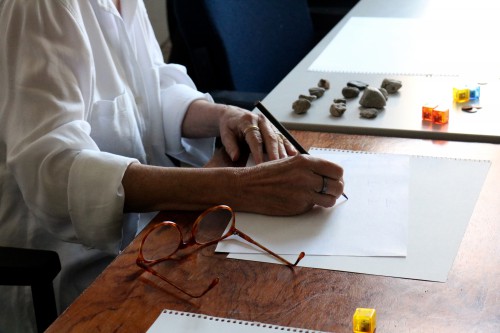
Ten Bard College Berlin students set around the factory building tables on a Friday evening, each provided with only two dice, pen, paper, and twelve rocks they were curiously required to bring with them beforehand. As Laura Kuhn, the director of the John Cage Trust and the John Cage Ryoanji Drawings workshop leader took out a thick book with a minimalistic cover and introduced it as an old Chinese oracle used for guidance and inspiration, the cynics among us moved uncomfortably in their seats. Some of us were vaguely familiar with John Cage’s work while others knew nothing about it, but none of us knew what John Cage had to do with the I Ching. John Cage (1912-1992) was an American post-war avant-garde composer, music theorist and an artist most known for using unorthodox musical instruments and “chance operations” as he derived them from the I Ching.
The workshop participants got to experiment with Cage’s chance operation technique under the guidance of Laura Kuhn, who is also a writer, director, arts administrator, and musicologist. Instead of being given the chance operation instructions beforehand, we followed Laura’s instructions step by step. Cage used his chance operation technique so as to avoid knowing in advance how his work was going to look like. It produced the famous Ryoanji paintings inspired by the Ryoanji Zen garden in Kyoto, Japan. The garden is composed of 15 rock formations emerging from the ground similarly to the rocks Cage placed on paper for his paintings. The placement of Cage’s rocks, however, was determined by chance. Our initial confusion turned into curiosity and enthusiasm as we first rolled our dice. For starters, we put our rocks on the table and numbered them in any way we wished. The dice determined the number of rocks we were going to use in our paintings. They also determined the number of times we were going to draw around each rock. This was the chance part. Some of us also used the dice to determine the number of colored pencils we were going to use, and if we numbered those, we could use the dice again to determine which color we were going to use for each tracing. In order to be able to handle also larger numbers, we later used an online “dice” that would randomly determine our numbers–all we had to do is to decide the minimum and maximum numbers we wanted for each category.

We enthusiastically anticipated our lot as numbers were announced for each one of us at a time, while calls such as “8 is a good number!” or “I hate 14, I wish I would have chosen a number on my own” were exchanged. As we started working individually on our drawings, each of us had developed more categories and more techniques to follow. For example, I rolled the dice in order to determine the number of angles in which I would trace every rock. Later on I turned my paper into a table of 6 columns and six rows, allowing the dice to determine the location in which I put the rock it instructed me to use. This was the choice part. Even though working with more categories was more fun, it also limited my choice and thus my creativity. While some of the participants chose not to use the dice to determine their colors or locations, others chose to construct and invent new techniques of chance.

As I kept on “limiting” my choice, I soon came to learn that choosing could simply not be avoided. The creative process was present whether we chose to choose, or whether we chose chance. The different outcomes of each one of the participants served as evidence that it wasn’t only the numbers on the dice that determined our works, but also our individually and creatively chosen categories. Every once in awhile, Laura would ask us “Do you like where this is going?”, “What would you have done differently?” Some of us realized that in fact, they did want to choose the colors they were using, while some wanted to add categories of chance to improve their work. As I limited myself, I learnt what I liked and where I wanted to have more freedom, and when I gave myself no instructions, I learnt where I could use some more guidance. Now I understood what Laura meant earlier when she said that Cage’s I Ching inspired chance operations are not about making decisions, but about making moves. Obviously enough, the chance operations technique is not only useful in a creative process, but could be applied to any kind of decision-making. It functions in a very similar way to flipping a coin. We all know the feeling we get when the coin falls on the side we actually wanted to turn upwards, realizing that we actually did know what we wanted in the first place. Decision making in our individual lives cannot always be made by rationalizing and overthinking consequences, and can definitely provoke anxiety, so it makes sense to flip a coin once in a while.
[hupso_hide]
